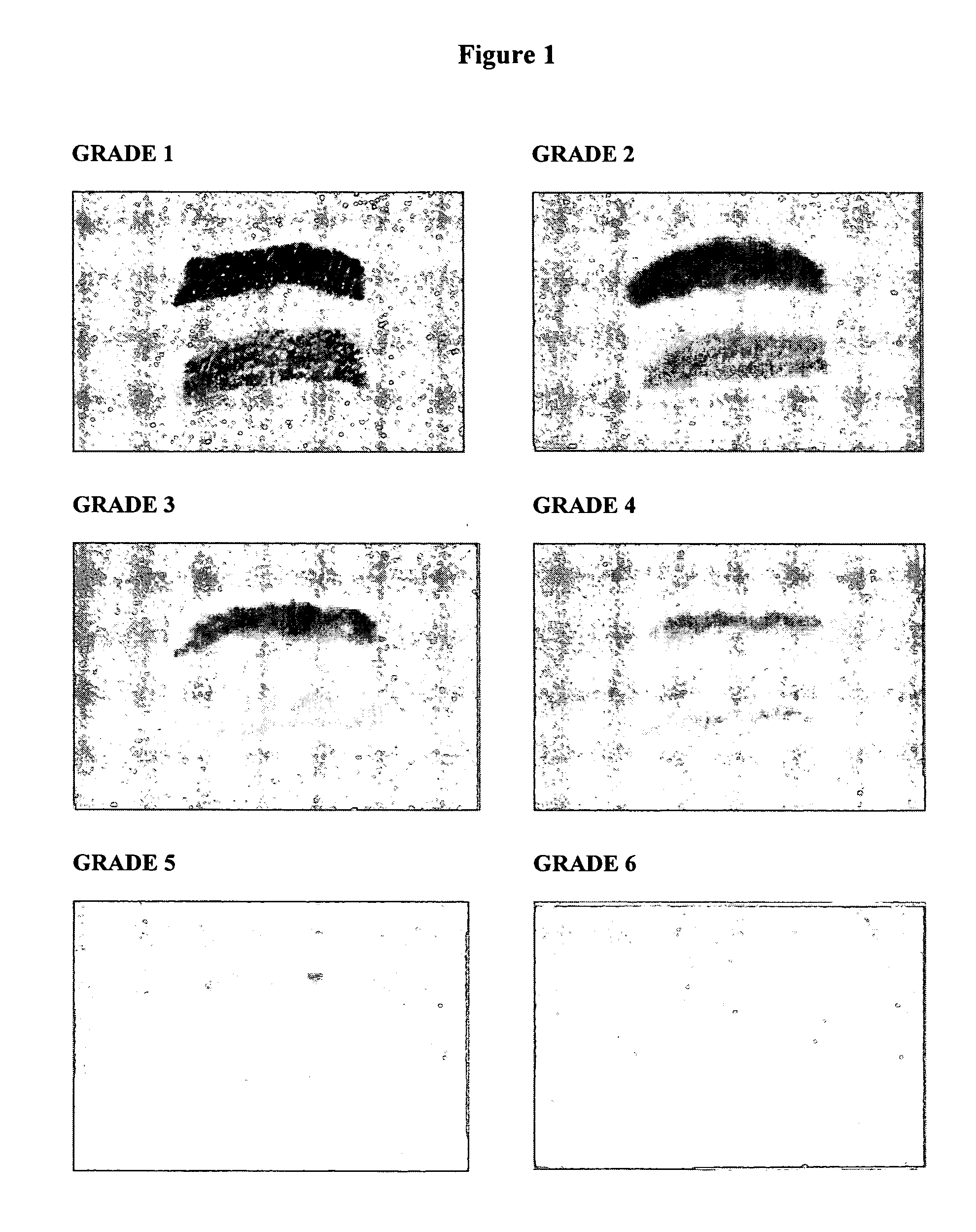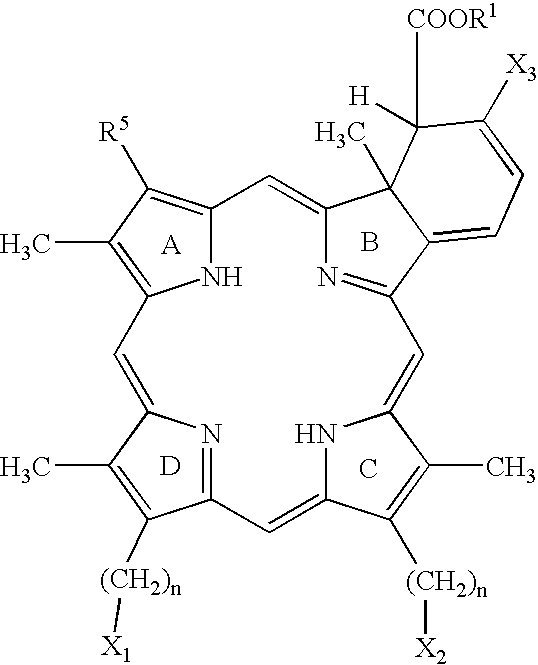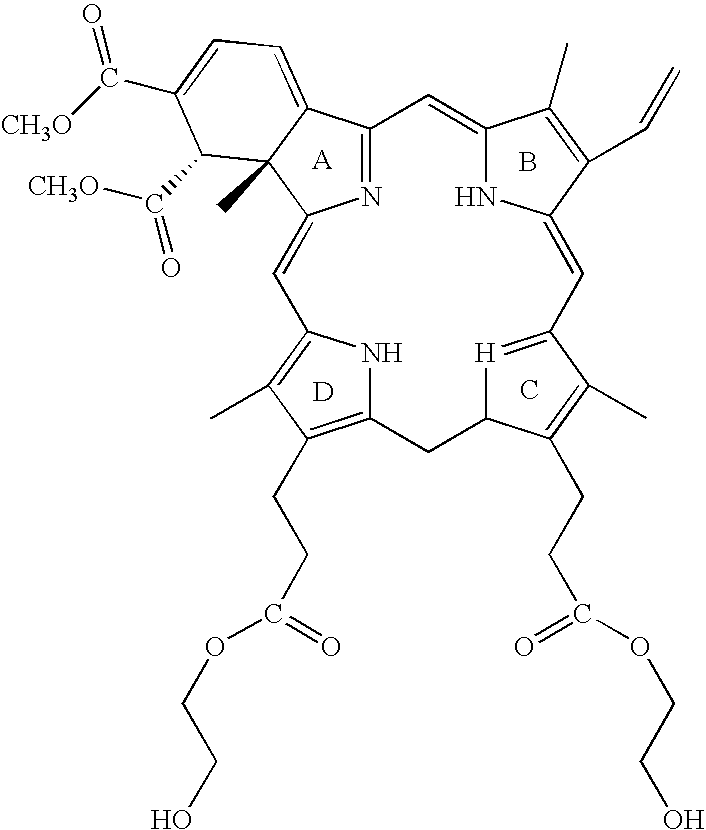Treatment of tattoos by photodynamic therapy
- Summary
- Abstract
- Description
- Claims
- Application Information
AI Technical Summary
Benefits of technology
Problems solved by technology
Method used
Image
Examples
example 1
[0074] Five guinea pigs were lightly anesthetized and shaved. Depilation of remaining hair was carried out using Nair®. Tattoos were applied using the Aims IIIA Tattoo Identification System with a 3-prong needle (Aims Inc, Hornell N.Y.) set at a penetration depth of 1 mm. Tattoo lines were applied side by side to create a rectangular filled area approximately 3×10 mm. Black ink (pigment #242, Aims Inc, Hornell N.Y.) and green / blue ink (pigment #270, Aims Inc, Hornell N.Y.) were used.
[0075] Three pairs of rectangles approximately 3×10 mm each were tattooed on each flank of each animal for a total of 6 tattoo sites on each flank. One tattoo of each pair was created using black ink, the other using green / blue ink. The tattoo pairs were side by side, at least 1 cm apart, on the animal's flank as shown in FIG. 1. The pattern was repeated on the opposite flank.
[0076] QLT0074 for injection (A-EA6 in U.S. Pat. No. 5,929,105) was reconstituted with Water for Injection to give a stock conce...
example 2
[0085] A tattooed human male having skin type II is given a skin photosensitivity test on skin area near the tattoo. No adverse skin reaction is observed. The skin over the tattooed area is shaved and the surface area estimated to be 3cm2.
[0086] QLT0074 for Injection is reconstituted with Water for Injection to give a stock concentration of 2.0 mg / ml and diluted with 5% Dextrose in water to a concentration of 0.2 mg / ml. The skin surface is cleaned and alcohol-disinfected. 30 intradermal injections are given using a syringe and a 30 gauge ½ long needle. The injections are at a depth of approximately 3 mm and spaced evenly across the tattoo. The total volume of composition injected is 0.5 mL. The skin is then wiped with gauze to remove any excess drug.
[0087] A template mimicking the tattooed area is applied on skin to limit the light exposure to the target area. Fifteen minutes after injection of the drug, the skin is exposed to 10 J / cm2 of LED-generated red light (688 nm-Q-100 LED ...
example 3
[0088] A tattooed human female having skin type II is given a skin photosensitivity test on skin area near the tattoo. No adverse skin reaction is observed. The skin over the tattooed area is shaved and the surface area estimated to be 4.5 cm2.
[0089] A Macroflux® transdermal patch is treated with topical photosensitizer ointment (comprising 0.2 wt % lemuteporfin, 50 wt % PEG-200, 24 wt % Transcutol®, 10 wt % PEG-3350 and 15.8 wt % oleyl alcohol) and then applied to the tattooed area. The Macroflux patch incorporates a thin titanium screen with microprojections that, when applied to the skin, creates superficial pathways through the skin's barrier layer allowing penetration of the photosensitizer. The patch is left in place for 1-2 hrs and then removed. Any excess photosensitizer is wiped away.
[0090] A template mimicking the tattooed area is applied on skin to limit the light exposure to the target area. The skin is then exposed to 15 J / cm2 of LED-generated red light (688 nm-Q-100 ...
PUM
| Property | Measurement | Unit |
|---|---|---|
| Fraction | aaaaa | aaaaa |
| Fraction | aaaaa | aaaaa |
| Fraction | aaaaa | aaaaa |
Abstract
Description
Claims
Application Information
 Login to View More
Login to View More - R&D
- Intellectual Property
- Life Sciences
- Materials
- Tech Scout
- Unparalleled Data Quality
- Higher Quality Content
- 60% Fewer Hallucinations
Browse by: Latest US Patents, China's latest patents, Technical Efficacy Thesaurus, Application Domain, Technology Topic, Popular Technical Reports.
© 2025 PatSnap. All rights reserved.Legal|Privacy policy|Modern Slavery Act Transparency Statement|Sitemap|About US| Contact US: help@patsnap.com



